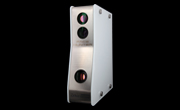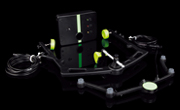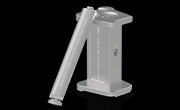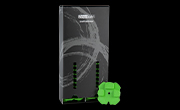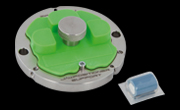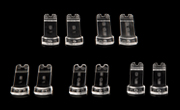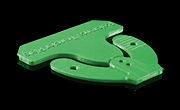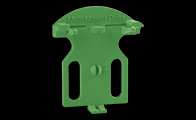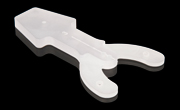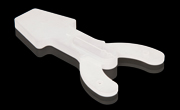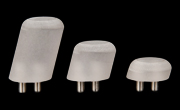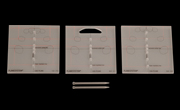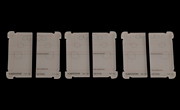PlaneSystem® by MDT Udo Plaster developed in cooperation with Zirkonzahn
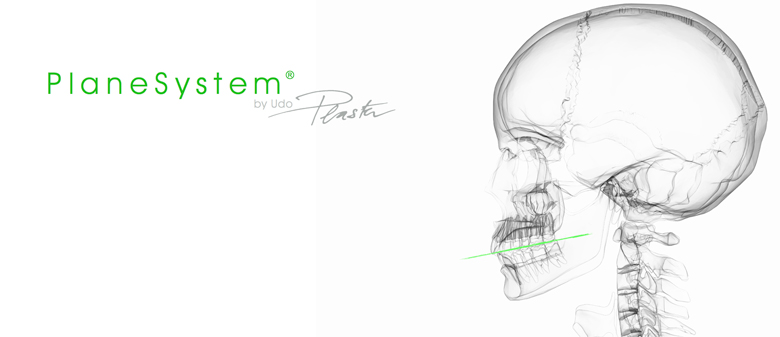
An innovative approach for capturing and measuring patient-specific occlusal information:
- position of the upper jaw,
- inclination of the occlusal plane,
- bite position,
- occlusal surface design,
- tooth set-up,
- lower jaw’s function analysis,
- and its relation to the upper jaw.
For a precise planning security, a comprehensive patient consultation and better communication between patient, dentist, orthodontist and dental technician.
Advantages
- inaccurate results through facebows or transferbows can be avoided,
- all data can be accurately matched in the articulator by means of reproducible reference planes,
- integration of data for functional analysis carried out by dental professionals,
- articulator with an innovative design,
- completely integrated in the digital workflow.
Reference planes – what’s new?
When detecting the patient’s reproducible Natural Head Position (NHP) by means of the PlaneFinder® measuring/registering device, it is usually possible to localize a horizontal reference plane for the patient‘s skull in the repeatable manner. During the registration, the patient intuitively positions the midline vertically and in the center of the device which allows the user to visualize and record the asymmetries from the patient‘s face on the right and left side of this vertical reference plane.
For information about PlaneSystem® courses please contact:
info@plasterdental.de | www.plasterdental.de
“Already with the transmission of the patient’s situation with the PlaneSystem®, the dental technician can save a lot of time, since the planes fit immediately. There is no longer the need to subsequently correct them which is mostly the reason for unnecessary time wastage and modifications. Just a little practice is necessary for its application. If everything is coordinated well, the transmission and bite registration takes more or less the same amount of time as with conventional working methods. […] This development is still very new to many customers. A dental technician can provide information and consult dentists, for example by means of brochures. In order to support this workflow and to get “best” data from it as a result, I often brought the PlaneFinder® along when I visited my customers. A small laboratory makes this unconventional approach possible. With my own initiative I was able to convince my customers to collaborate with me, since the detection of the patient’s situation is usually the dentist’s task. […] Basically, the amount of work for a dentist is not much, less than when applying conventional working methods.” Dental technician Karin Engelhart (Dental-art laboratory, Tönisvorst). Interview with the Quintessence Zahntech magazine, 2016;42(4):531-535.
Planesystem®-Components
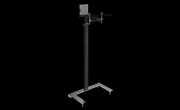 |
PlaneFinder® Device used to detect the Natural Head Position (NHP) as well as the occlusal plane angle Item number: SYAA0360 |
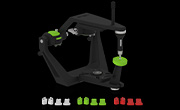 |
PS1 Articulator Physical and virtual articulator designed with special geometries to simulate patient-specific rotating, sliding and closing movements of the jaw as they occur during mastication Item number: SYAA0350 |
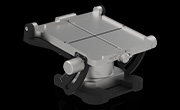 |
PlanePositioner® Platform used to position the maxillary cast in the PS1 articulator and to reproduce the occlusal plane Item number: SYAA0370 |
Ideal in combination with
Planesystem®-ACCESSORIES
An overview of the workflow
Registration of data (in the dental practice)
| Position of the maxilla in the Natural Head Position (NHP): | |
|---|---|
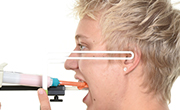 |
Manually With registration material on a (horizontally aligned) tray on the PlaneFinder®. Digitally With the Face Hunter and the PlaneFinder®. |
| Inclination of the ala-tragus reference in the Natural Head Position (NHP): | |
|---|---|
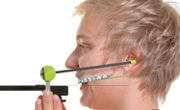 |
Manually On both sides with measuring angles on the PlaneFinder® in relation to the horizontal reference plane. Digitally Indication of the relevant anatomical points (Ala nasal/Ala Tragus) on the 3D Face Hunter scan, automatic measuring through the software. |
| Mandibular movements: | |
|---|---|
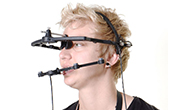 |
Digitally With the jaw registration system Plane Analyser (does NOT replace an expert functional analysis carried out by dental technical qualified personnel). |
Data transfer into the PS1 articulator (in the dental practice or in the lab)
The captured data are then matched in the PS1 articulator on the basis of the horizontal reference plane.
| Position of the maxilla: | |
|---|---|
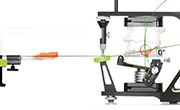 |
Manually Alignment of the registration material on the (horizontally positioned) PlanePositioner® on the basis of further parameters (skelatal midline/masticatory centre), insertion of the PlanePositioner® in the PS1 articulator, inserting the maxillary model in the registration material and plastering the model on the upper articulator arm. Digitally Through matching, the model is brought into the correct position in the facial scan with the help of the Transfer Fork (Bite Tray Face Hunter) Digital data concerning the position of the maxilla can be transferred at any time into the laboratory articulator to carry out manual control steps or working steps. To do so, an occlusal positioning pattern is milled out of the JawPositioner milling blank with one of the Zirkonzahn milling units, and is then placed on the PlanePositioner®, similar to the registration material in the conventional data registration. |
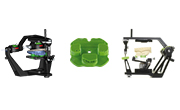 |
|
| Inclination of the ala tragus line/occlusal plane: | |
|---|---|
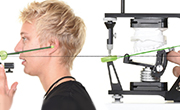 |
Manually Display of the occlusal plane (which can have a varying inclination) by adjusting the measured “ala tragus angle” with the help of the two pivoting halves of the table on the PlanePositioner®. Digitally Has already been carried out during data registration |
| Mandibular movements: | |
|---|---|
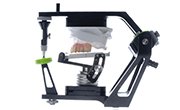 |
Manually Settings for the PS1 articulator result from the Plane Analyser’s measurement log. Digitally Import function in the Zirkonzahn.Modellier software (in preparation). |
| The digitisation of the manually captured data is carried out with the S600 ARTI model scanner and the Zirkonzahn.Scan software. Subsequently, they can be combined with patient photos or 3D facial scans (Face Hunter). The entire system can be ideally combined with the model-/patient analyses according to Udo Plaster. | |
The third dimension in patient analysis
In clinical practice, incorrectly inclined occlusal planes and functionally inadequate restorations are a common scourge. A possible reason is the often imprecise analysis of patient information. Now Udo Plaster, master dental technician from Nürnberg, has developed a novel transfer approach, the PlaneSystem®.
It determines the occlusal plane and any associated asymmetries individually for each patient based on the ala-tragus plane and natural head position (NHP) and transmits the real position to the CAD/CAM system.
For an uninterrupted digital workflow, the data received and the corresponding coordinates in three-dimensional space must be correctly matched. This can be done with the S600 ARTI structured-light optical scanner and the virtual articulator implemented in the Zirkonzahn design software. The scanner acquires the data of the models from the PS1 articulator and transfers them directly to the software’s virtual articulator.
This allows possible compensations to be detected prior to developing a treatment plan for laboratory or chairside restorations, minimising or completely eliminating any sources of error, particularly during data transfer, which might otherwise occur when planning or fabricating a dental restoration.

The next step is the actual modelling of the restoration in the design software Zirkonzahn.Modellier. Ideally, the physiognomy of the patient is taken into account during this step. This is now made possible by the Face Hunter 3D facial scanner.
The almost photo-realistic digital face data of the patient can be used either as validity or reference values, but are also ideal for the planning and consultation process between dentist and patient.
Scientific background to the Plaster transfer approach
Ala-Tragus Line

Scientific studies, e.g. by Xie and coworkers, have identified the connecting line from the lower edge of the nasal wing to the centre of the tragus, the so-called ala-tragus line, to be a more reliable reference for the occlusion line than Camper’s plane or the Frankfurt horizontal plane. The deviation of the ala-tragus plane from the occlusal line is minimal. The ala-tragus line varies from patient to patient, with hemifacial asymmetries a not infrequent occurrence. In order to reliably reproduce the occlusal plane, it is necessary to determine it independently of skeletal class.
The Natural Head Position (NHP)

The second important point of reference within Plaster’s method of transfer is the natural head posture (NHP). A 5-year study by Cooke (2) has shown that patients’ natural head posture varies by only one to two degrees when looking directly into his or her own eyes as they stand upright in front of a mirror. This result is supported by a 15-year study by Peng et al.
The NHP is related to a patient-independent reference frame that allows patient-specific variations in spatial orientation to be reproduced.

